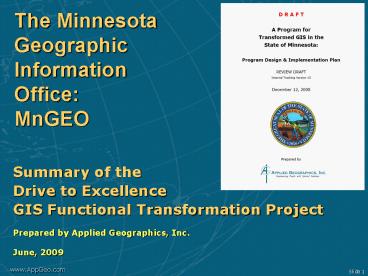The Minnesota Geographic Information Office: MnGEO - PowerPoint PPT Presentation
1 / 16
Title:
The Minnesota Geographic Information Office: MnGEO
Description:
Collaborative approach respectful of agency involvement in developing technical architecture ... Missing the unique timing of the Drive to Excellence initiative ... – PowerPoint PPT presentation
Number of Views:11
Avg rating:3.0/5.0
Title: The Minnesota Geographic Information Office: MnGEO
1
The MinnesotaGeographic Information
OfficeMnGEO
- Summary of the
- Drive to Excellence
- GIS Functional Transformation Project
- Prepared by Applied Geographics, Inc.
- June, 2009
2
Overview
- The process that was followed
- The business drivers for transformation
- What was recommended
- What happens now?
- Risks
- Success factors
3
Overview of the GIS Functional Transformation
Project
- Open and transparent process
- No surprises
- Lots of opportunity to provide input
- Information gathering
- Workshops
- Interviews with 17 state agencies
- Strategizing and recommendation development
- State government workshop to refine preliminary
recommendations - Supplemental information gathering
- Cost to government survey
- Prioritization survey
- Oversight and guidance from Drive To Excellence
Steering Committee
4
Business Drivers for GIS TransformationAs with
all things D2E, its about silos to enterprise
- Minnesota Drive to Excellence Transformation
Roadmap SummaryFrom Deloitte March, 2005
5
Common problems many states face
- GIS governance has grown up incrementally and
organically not necessarily strategically - How to achieve coordination?
- Agency to agency
- State government to other levels of government
- Whos job is it? Its not a part-time job.
- Acknowledging that many departments have
successful enterprise systems - Departmental programs can be larger and better
funded than the state GIS office - Respecting departmental autonomy and expertise
without creating hardened silos - Investing in new enterprise technologies
- Without being redundant
6
High level business case for the MGIO
- Enterprise approach
- New adopters Lowers barriers for entry
- Avoids costs for new investment
- Specialized adopters Provides communal
infrastructure to tap into - Controls growth of costs
- Mature adopters Leverages their investments
across the enterprise - Extends benefits of existing investments
- Creation of Shared Service Centers
7
The Cost of GIS to GovernmentProvides a baseline
for cost savings estimation
- GIS cost to government
- Conservatively12,564,000 /yr
- 10 efficiency would yield gt1M/yr. savings
- Controlling growth of costs
- Future avoided costs
- Have not seen this completed for any other state
- Thank you for your help!
8
Opportunities Benefits
- Reducing the Cost of GIS
- Improved coordination
- Reduced duplication of effort
- More efficient data storage/management
- More effective software licensing
- Shared web applications and services
- Coordinated data acquisition, collection and
compilation - Common data distribution portal
- Communal strategic investments in data/technology
9
Whats required to get there?
- Identified specific activities for the MGIO to
pursue - Collaborative approach respectful of agency
involvement in developing technical architecture - Accesses departmental expertise to deliver shared
services
10
Recommended Implementation Strategy
- Principles
- The MGIO is about facilitation and coordination,
not production - Leverage existing infrastructure and
collaborative spirit of MN GIS stakeholders - Incremental, phased approach
- Budgets will remain tight for the foreseeable
future - Priorities
Rank Program Element Priority Points (of 100)
1 Leadership, Outreach Communication 18.33
2 Data Coordination 15.80
3 Web Services 14.00
4 Data Services 13.20
5 Technology Coordination 12.07
6 Training 9.27
7 Technical Guidance 8.87
8 Project Consulting 8.47
TOTAL Points 100.00
11
Staffing Requirements for a Successful MGIO
- High-level identification of teams
- Rough numbers of staff across activities
- Provides baseline that was modeled in budget
scenarios
12
How ambitious is this?What other states are doing
13
Implementation Budget
- Recommended funding
Num Item Amount FTE
1 Base budget (existing LMIC appropriation) 804,000 6
2 New operating budget to fully staff the MGIO 800,000 10
3 New operating budget 200,000
4 New data development and maintenance funding 1,250,000
Sub-tot TOTAL Annual Appropriation 3,054,000 16
5 OTHER revenue (based on 2009 estimates) 700,000
- 3 Additional Lower Cost Scenarios
- 650k operating increase 1M for data 2.54M
annual 11 FTE - 400k operating increase 250k for data 1.45M
annual 9 FTE - 350k operating increase 0 for data 1.15M
annual 9 FTE - Warning against a no new funding scenario
- Real transformation will be much more difficult
without some new resources
14
Risks Implementation Barriers
- Missing the unique timing of the Drive to
Excellence initiative - Loss of executive support for the proposed
transformation - Agency GIS programs need direction to follow this
path - Loss of agency GIS program support for the
proposed transformation - MGIO needs to continue transparency and active
outreach to agencies - Perceptions of insufficient transformation
- Inadequate funding
- Insufficient support for cross agency activities
- Inadequate performance of shared services and
resources
15
Success factors
- This is a well considered plan
- The state has done its homework
- There is senior executive support
- Through the D2E Cabinet
- The MN State Government GIS Community is
committed and collaborative - And continues to grow
- New technologies support this vision
16
Summary Conclusion
- A large cross section of GIS practitioners from
across the state, have invested time and energy
in this process with the belief that this type of
GIS transformation will address existing problems
and help restore Minnesota to national GIS
leadership. Expectations are high. The path
forward has been identified. It is now time to
move forward.































